mechanical shear
Understanding Mechanical Shear Principles and Applications
Mechanical shear is a fundamental concept in engineering and materials science that describes the deformation that occurs when a force is applied parallel to the surface of a material. This action leads to a sliding effect, ultimately modifying the material's shape or structure without altering its volume. Understanding mechanical shear is crucial for various applications, from manufacturing processes to structural engineering.
The Basics of Mechanical Shear
Shear stress is defined as the force per unit area exerted parallel to the applied surface. Mathematically, it can be represented as
\[ \tau = \frac{F}{A} \]
Where \( \tau \) is the shear stress, \( F \) is the applied force, and \( A \) is the area over which the force is applied. The nature of the material plays a significant role in how it responds to shear stress. Materials can be categorized as ductile, which can deform significantly before breaking, or brittle, which may fracture under relatively small amounts of shear stress.
Moreover, the shear strain is the measure of deformation that occurs as a result of the applied shear stress. It is expressed as a ratio of the change in position of one part of the material relative to another to the height or thickness of the material.
Mechanisms of Shearing
mechanical shear

Two primary mechanisms can occur during mechanical shear plastic deformation and elastic deformation
. In plastic deformation, when the shear stress exceeds the material's yield strength, it results in permanent deformation. Conversely, in elastic deformation, the material will return to its original shape once the shear stress is removed, given that the stress levels are below the material’s yield strength.The shear rate, which refers to the rate at which adjacent layers of material move relative to each other, is also a critical factor in understanding mechanical shear. It plays an important role in processes such as fluid dynamics; for example, in the flow of viscous fluids, the shear rate can significantly affect how well the material flows or how it behaves under stress.
Applications of Mechanical Shear
Mechanical shear is integral to various industrial processes. For instance, in manufacturing, shear stress is a key factor in the operations of cutting, bending, and forming materials. Shearing machines are employed to cut metals and other materials into desired shapes and sizes by applying a force that exceeds their shear strength.
In the automotive industry, mechanical shear plays a significant role in the processes involved in forming and assembling vehicle components. Engineers often design parts that can withstand various shear loads during operation, such as when a vehicle turns or experiences sudden changes in speed, ensuring durability and safety.
Similarly, in construction, structures must be designed to handle the shear forces that arise during events like earthquakes or high winds. Understanding how materials behave under shear forces enables engineers to design buildings, bridges, and other infrastructures that are resilient under dynamic loads.
Conclusion
Mechanical shear is a vital concept that bridges various engineering disciplines and applications. From manufacturing processes to structural integrity assessments, the understanding of shear stress, strain, and its effects on materials is essential for innovative designs and safe constructions. By employing principles of mechanical shear, engineers and scientists can enhance the performance and reliability of components across multiple industries. As technology advances, ongoing research and development in this area will undoubtedly lead to more efficient materials and processes, further emphasizing the importance of mechanical shear in engineering and material science.
-
High Frequency Straight Seam Welded Pipe Production Line|BzZhou Xinghua|Precision Welding&EfficiencyNewsJul.30,2025
-
High Frequency Straight Seam Welded Pipe Production Line - BzZhou Xinghua|Precision Engineering&EfficiencyNewsJul.30,2025
-
High-Frequency Straight Seam Welded Pipe Production Line-BzZhou Xinghua Machinery Equipment Manufacturing Co., LTD.NewsJul.30,2025
-
High-Frequency Straight Seam Welded Pipe Production Line-BzZhou Xinghua Machinery Equipment Manufacturing Co., LTD.|Precision Manufacturing, High EfficiencyNewsJul.30,2025
-
High Frequency Straight Seam Welded Pipe Production Line-BzZhou Xinghua Machinery Equipment Manufacturing Co., LTD.|Precision Steel Pipe Manufacturing&Industrial EfficiencyNewsJul.29,2025
-
High-Frequency Straight Seam Welded Pipe Production Line-BzZhou Xinghua Machinery Equipment Manufacturing Co., LTD.|Precision Steel Pipe Manufacturing&Industrial EfficiencyNewsJul.29,2025


